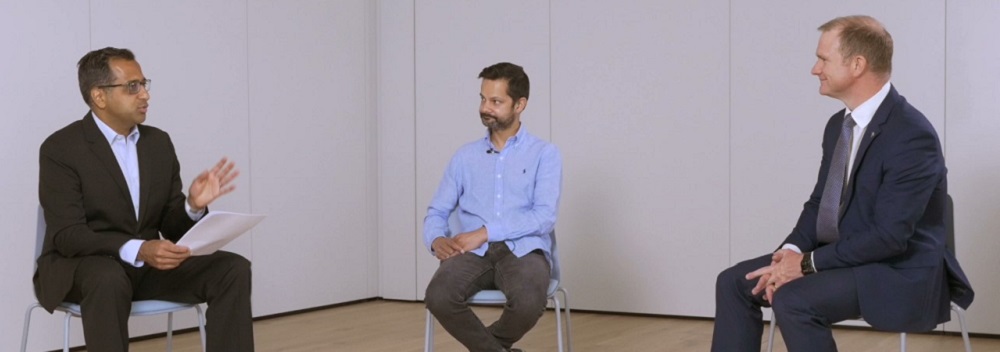Legal & General Insurance's CEO: prioritising financial wellbeing of employees
- 8 Min Read
Bernie Hickman, Legal & General Insurance’s CEO, and Asesh Sarkar, Global CEO of Salary Finance, outline the important role healthy finances play in our overall wellbeing.
- Author: Fin Murphy
- Date published: Jun 24, 2021
- Categories

The last year has proven tumultuous for the wellbeing of people the world over. Whether it be the threat of a potentially deadly virus, the loss of livelihood or the psychologically overwhelming culmination of several stress factors – it’s no surprise businesses have prioritised wellbeing.
Our financial position plays a pivotal role in how we feel. Being cash-strapped just ahead of pay-day, mounting and insurmountable credit card bills can cause stress and anxiety – having a detrimental effect on overall wellbeing.
Many professionals have been working less or placed on furlough, and face an uncertain future; from September to November 2020, 395,000 redundancies were reported in the UK. Additionally, mental, physical, and financial issues are interrelated and have knock on effects; for instance, sleep loss was found to occur more in UK adults with perceived financial difficulties.
That said, with vaccination schemes running across the world, there are tentative signs of moving past the pandemic; on the other hand, professionals will have to address the immediate and long-term effects of the unmatched stress they’ve endured.
With the greater focus on wellbeing in organisations, HR leaders are asking: how can we best support staff now and post-pandemic? In what ways do we tailor strategy to suit different levels of the workforce? How can leaders best utilise communications to aid wellbeing and engagement?
Offering insight are Bernie Hickman, CEO of Legal & General Insurance, and Asesh Sarkar, Global CEO of Salary Finance.
Incorporating learnings into hybrid working
Hickman notes the shift from pandemic conditions into hybrid working, plus the need for employers to take the lead in supporting staff who may face a diverse number of challenges.
“Now we’re starting to help people back into the workplace. It’s all about wellbeing, but we’ve never put as much focus on it as an organisation. Looking at all aspects – physical wellbeing, mental wellbeing, employee financial wellbeing.
“It’s never been as apparent, making sure that we can be flexible, and tailor what we’re offering as an employer. How do you offer things for everyone, but in a way that they can be tailored and appropriate for the different individuals in very different circumstances?”
Sarkar concurs and explores the number of ways that professionals’ circumstances can vary.
“We’ve never thought about the wellbeing of our people outside of work more than we have now, and you start to realise that not everyone is the same. Younger members of our team are often in rented properties, working in their bedroom daily, and without formal equipment. It can be quite challenging.
“Home-schooling clearly brings many challenges. Isolation is a challenge for people that live alone. On the other hand, some team members had a nice office, saw their family a bit more, and walked the dogs at lunch. Now we’re trying to incorporate the fact that different people have different needs, and are designing wellbeing initiatives accordingly.”
The importance of open communication
With teams separated by necessity, and some degree of remote working set to remain prominent, Hickman notes the need for clear and effective messaging.
“There’s always a communication challenge, so we’ve been communicating a lot. You can’t over communicate, but we’ve found that at some points, if you just keep doing the same method, it can just lose impact, and you may as well not be doing it. We’ve had to rein back in and challenge ourselves to think of different ways of communicating and engaging with people, to keep it fresh and relevant.
“Not all online collaboration works very well. Some of the experience of the last 18 months is how important face to face, in-person contact is for specific things, solving tough problems that go across multiple teams, for instance.”
Sarkar notes the benefits of encouraging team members to recognise and support each other in an organic fashion.
“We’ve done a lot regarding recognition. On our team messaging platform, people are encouraged publicly to thank someone for what they’ve done. This is incredibly heart-warming to see, people going out of their way to thank people that recognise them, and I think that creates a nice culture of appreciation.
“Everyone works hard, everyone has their stresses, and it’s just nice to be recognised, which can be more hard if it is quite transactional day to day.”
How posting correspondence hits home
Leaders have remarked on the swift pace of digital change due to the shift to remote working, but Hickman has a surprising tip for leaders looking to connect with their teams, and offer clarity.
“One of the slightly counterintuitive learnings is the really good quality of old fashioned postal communication, particularly when everyone is working from home. Partly because it’s different; you don’t get as much personalised kind of communications like that. That’s certainly been one of the ways to cut through because it is more challenging to communicate when you haven’t got people all together in the workplace.
We do paper-based benefits statements and they work really well to help people understand all the wide range of benefits that they get from working for us. We’ve proven again that that kind of cuts through.”
Focusing on employee financial wellbeing
Having discussed internal processes at L&G, Hickman goes on to explore the role that organisations should be playing in relation to employee financial wellbeing.
“The employer has got an important role to play. Most employers do provide some form of benefit, but how many of their employees realise that they’ve got it? Plus, how much is the employer paying already?”
Hickman outlines L&G’s Protect offering, and how it can be a boon for organisations and teams alike. Protect, built in collaboration with Salary Finance, is a cutting-edge workplace protection benefits experience that enables employees to personalise their cover on-demand. Flexibility, control and personalisation are all values this offering gives its users.
“One of the big advantages of Protect is that it is inherently more engaging, because you can personalise it, and it is done digitally. It’s vital to get much more value out of the money. You don’t have to pay any more as an employer, but you get a more engaging offering. You can go to your employees, show them what benefits they have and how much the company is paying.
“When employers are looking to see what they can do to help wellbeing in all its aspects, Protect really fits into that. This isn’t about spending more, it’s about making use of the great technology platforms and the great innovation that’s out there to deliver so much more for employees.”
Tailoring strategy to individual needs
All levels of the workforce, from the C-suite to frontline staff have faced new pressures. Hickman highlights one group particularly at-risk in home working conditions.
“With our junior people, their situation is much less suited to home working and we’re seeing short and long-term sickness coming through, with mental wellbeing a key source of that. I think we’re conscious that more senior roles, perhaps it’s slightly more under the surface, but no less prevalent.
“Fortunately, we’ve got a lot of help in place already. Some of that comes with the insurance benefits that we provide, employee assistance and help lines, which are available to our employees or clients. It’s really important to encourage managers to step up and all get on board with taking more interest in the individuals that are working for them and making sure that they’re there to spot the signs and flag up the right support.”
Sarkar agrees and explains how colleagues’ connections can suffer in remote working conditions, plus the need to emphasise the benefits of positive relationships.
“There are good things about working from home; you cut out the commute, you could be a bit more productive, see family, but there are lots of negatives as well. You don’t really build relationships with your colleagues over video conference. I think when you are working in a video only environment, particularly if you’re new in the organisation, then actually your relationships are largely transactional
“Some level of balance is needed. We’re certainly keen to build the culture, build the relationships, build the camaraderie that there’s an element of with in-person working. It’s only when you come in that you see those benefits again. We’re certainly thoughtful about how we encourage people to come in when it when it’s right to do so, but when they do, they feel the benefits as well.”









